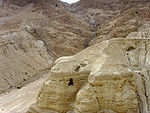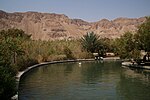Qumran

Qumran (Hebrew: קומראן; Arabic: خربة قمران Khirbet Qumran) is an archaeological site in the West Bank managed by Israel's Qumran National Park. It is located on a dry marl plateau about 1.5 km (1 mi) from the northwestern shore of the Dead Sea, about 10 km (6 mi) south of the historic city of Jericho, and adjacent to the modern Israeli settlement and kibbutz of Kalya. The Hellenistic period settlement was constructed during the reign of Hasmonean leader John Hyrcanus (134–104 BCE) or somewhat later. Qumran was inhabited by a Jewish sect of the late Second Temple period, which most scholars identify with the Essenes; however, other Jewish groups were also suggested. It was occupied most of the time until 68 CE and was destroyed by the Romans during the First Jewish–Roman War, possibly as late as 73 CE. It was later used by Jewish rebels during the Bar Kokhba revolt. Today, the Qumran site is best known as the settlement nearest to the Qumran Caves where the Dead Sea Scrolls were hidden, caves in the sheer desert cliffs and beneath, in the marl terrace. The principal excavations at Qumran were conducted by Roland de Vaux in the 1950s, and several later digs have been carried out. Since the 1967 Six-Day War, Qumran has been managed by the Israel Nature and Parks Authority.
Excerpt from the Wikipedia article Qumran (License: CC BY-SA 3.0, Authors, Images).Qumran
מעלה קומראן, Megilot Yam HaMelakh Regional Council
Geographical coordinates (GPS) Address External links Nearby Places Show on map
Geographical coordinates (GPS)
| Latitude | Longitude |
|---|---|
| N 31.740833333333 ° | E 35.458611111111 ° |
Address
קומראן
מעלה קומראן
Megilot Yam HaMelakh Regional Council
Judea and Samaria, Palestinian Territories
Open on Google Maps









